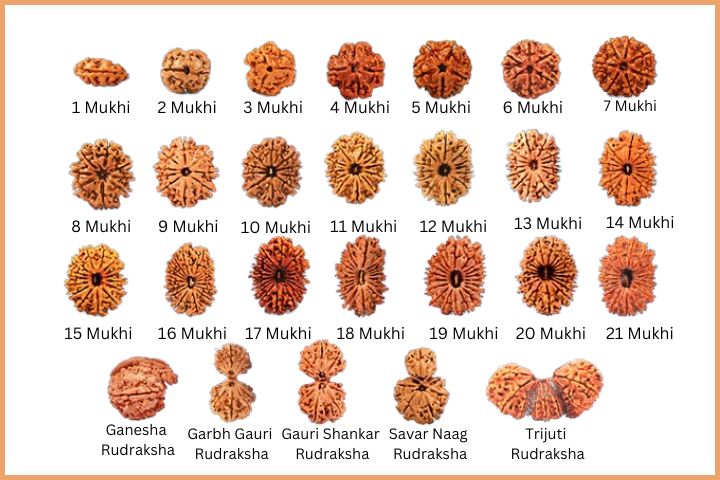Rudraksha beads hold a special place in spiritual practices across the world, especially within the Hindu tradition. Rudraksha, also known as the tears of Shiva, these sacred beads are revered not only for their deep spiritual symbolism but also for their potential to bring calm, protection, and clarity to those who wear them.
People believe that each Rudraksha carries the essence of the universe and embodies Lord Shiva’s blessings. Saints, yogis, and spiritual seekers wear Rudraksha beads, seeing them as powerful tools that support meditation, foster inner peace, and encourage self-discovery.
In this article, we’ll explore the fascinating mythology, scientific insights, types, and benefits of Rudraksha. We will explain why spiritual practitioners and devotees alike cherish these beads and how they connect with the sacred energy of Shiva.
The Spiritual Significance of Rudraksha
Saints, yogis, and seekers have worn Rudraksha beads for centuries. People believe that each bead holds the essence of the entire cosmos and embodies the blessings of Lord Shiva. When worn, Rudraksha helps in achieving inner peace, better health, and a fearless life. Devotees see Rudraksha as a sacred bridge between humanity and the divine, helping individuals in their journey toward higher consciousness and self-discovery. Artists and devotees often depict Lord Shiva adorned with Rudraksha beads on his head, arms, and neck, signifying their divine protection and energy.
The Mythology Behind Rudraksha

In Hindu mythology, Lord Shiva, also known as Rudra, is revered as the destroyer of misery and ignorance. The name Rudra has several meanings, often referring to Shiva’s role in cosmic dissolution. Ancient texts like the Rig Veda highlight Shiva as the one who eradicates sorrow, turning tears of pain into tears of bliss. This divine transformation is embodied in the Rudraksha beads, which represent a source of protection and blessings for humanity.
According to the myth in the Shiva Purana, Shiva entered a prolonged state of meditation to uplift the souls suffering in the material world. Upon emerging, his tears fell on Earth, giving rise to the Rudraksha trees. You can most commonly find these trees in regions like Nepal, India, Indonesia, and the foothills of the Himalayas, where the climate supports their growth. Devotees believe that the beads from these trees carry profound spiritual energy and assist them in their spiritual and worldly pursuits.
Scientific Understanding of Rudraksha

Known scientifically as Elaeocarpus Ganitrus, the Rudraksha tree is a large, evergreen tree that flourishes in tropical and subtropical climates. When the seeds are fully ripe, they have a blue outer shell, which is why people call them blueberry beads. Shiva, who is often shown in blue, is represented by this special appearance, symbolizing the endless universe.
Researchers have looked into the electromagnetic properties of Rudraksha beads, thinking that these properties can improve human health in addition to their spiritual meaning. Studies by researchers, such as Dr. Suhas Rai in Varanasi, suggest that Rudraksha beads emit a subtle energy that can regulate blood pressure, improve mental clarity, and help balance the body’s energies. This makes them an invaluable tool not only for spiritual seekers but also for those seeking physical and emotional well-being.
Different Types and Benefits of Rudraksha
Rudraksha beads come in various forms, each with a specific number of mukhis or faces, ranging from 1 to 21. Each type is associated with different divine qualities and benefits:

- 1 Mukhi: This rare bead, which is associated with Shiva himself, is said to awaken a sense of supreme consciousness.
- 2 Mukhi: Represents harmony, symbolized by the combined energies of Shiva and Shakti.
- 3 Mukhi: This Rudraksha, related to the fire god Agni, is believed to help release past karmic bonds.
- 4 Mukhi: Known as the knowledge bead, it helps seekers on the path of wisdom.
- 5 Mukhi: The most common type, it fosters inner peace and self-awareness. It is called Panchamukhi Rudraksha Mala.
Each Rudraksha type carries unique spiritual benefits. For instance, the 8 Mukhi associates with Ganesha and aids in the removal of obstacles, while the 9 Mukhi represents the powerful energy of Goddess Durga. Higher-faced Rudraksha beads are rare and highly valued for their potential to elevate consciousness and spiritual powers.
Rudraksha’s Role in Meditation and Protection

People traditionally use Rudraksha beads in prayer, commonly stringing them together as a mala with 108 beads. The major advantage of using beads in meditation is that they help you maintain focus and instill a sense of calm and serenity. Many spiritual practitioners use them during Japa, or mantra repetition, which helps deepen meditation and enhance spiritual growth.
People also believe that wearing Rudraksha protects against negative energies and planetary influences. For this reason, Rudraksha is cherished as a talisman for health, mental clarity, and peace. Many believe that Rudraksha mitigates negative karma and shields the wearer from misfortune, creating an aura of divine protection around them.
Embracing Rudraksha in Everyday Life
For devotees of Shiva, Rudraksha is more than just a bead; it is a reminder of Shiva’s presence and compassion. It brings the mind and body into harmony, helping one face life’s challenges with resilience and courage. As Gurudev Sri Sri Ravi Shankar has explained, wearing Rudraksha isn’t mandatory, but its benefits can be transformative if embraced with faith and devotion. People believe that a Rudraksha, regardless of its type, brings positive energy and helps align one’s soul with divine consciousness.
Conclusion
The connection between Shiva and Rudraksha goes beyond mythology; it is a testament to Shiva’s compassion for all beings. Wearing Rudraksha is a way to honor this connection, inviting peace, health, and spiritual elevation. For those on the spiritual path, Rudraksha serves as a powerful tool for meditation and an emblem of divine grace. Truly, these “tears of Shiva” are a gift to humanity, bridging the gap between earthly existence and the divine.

